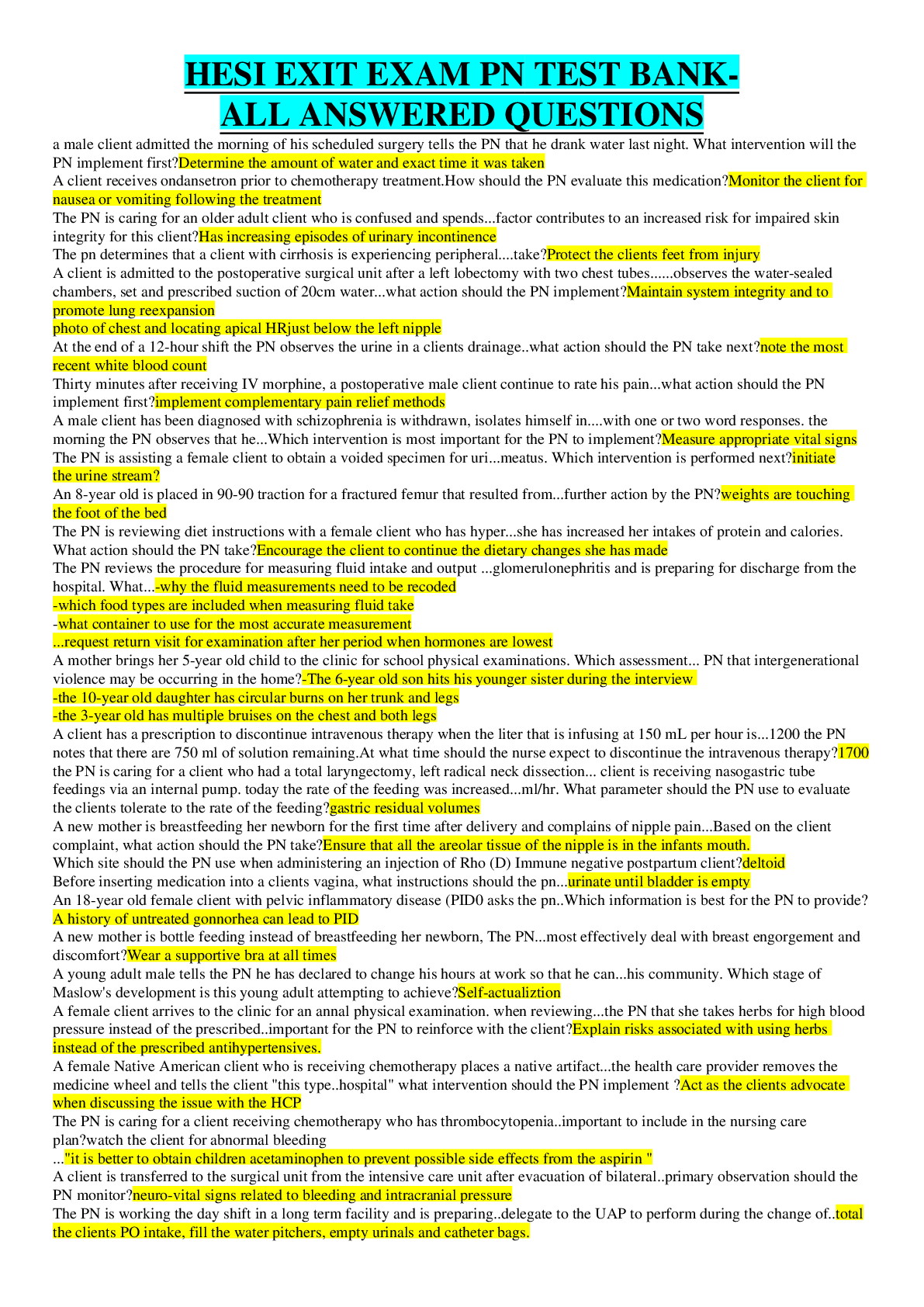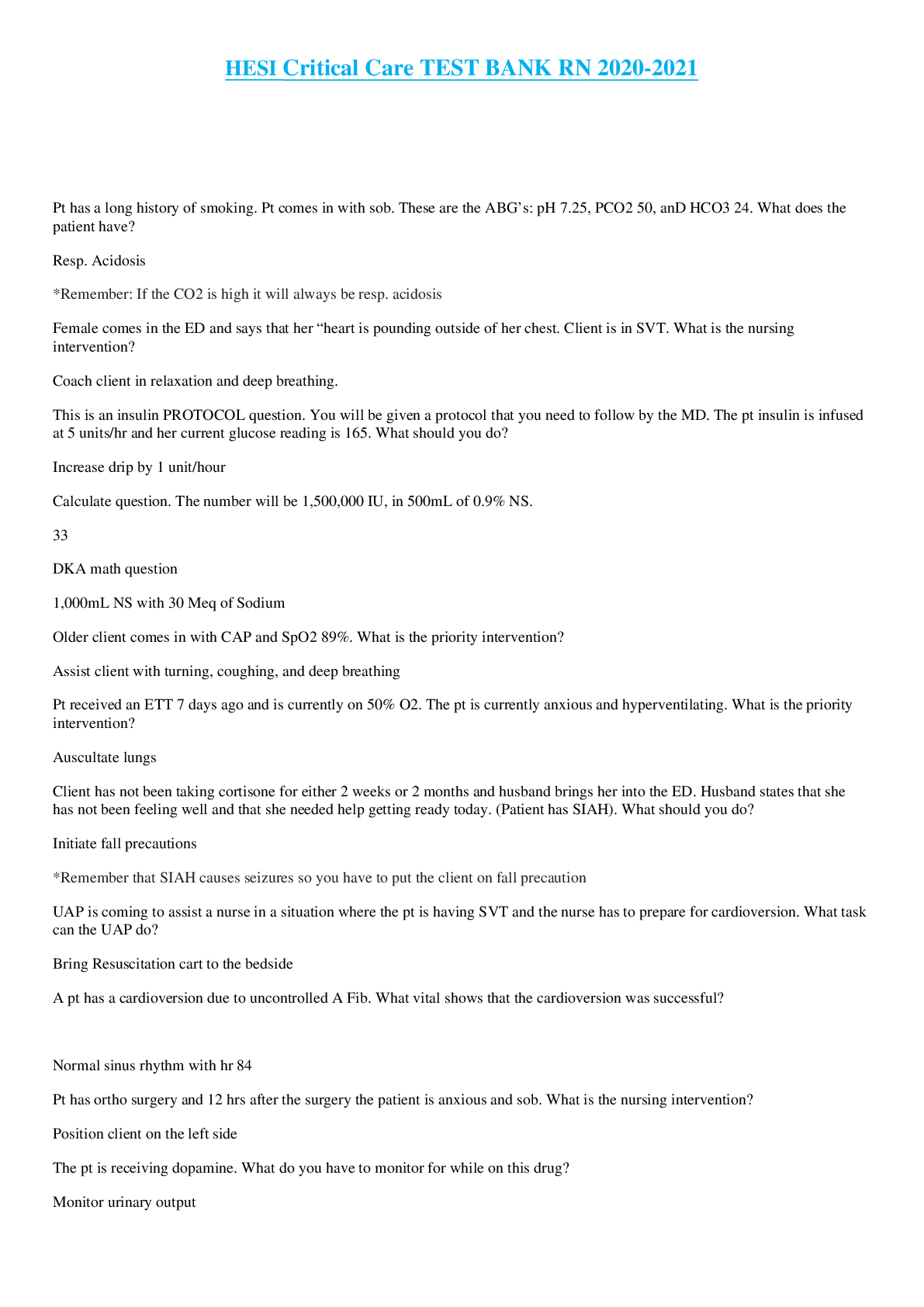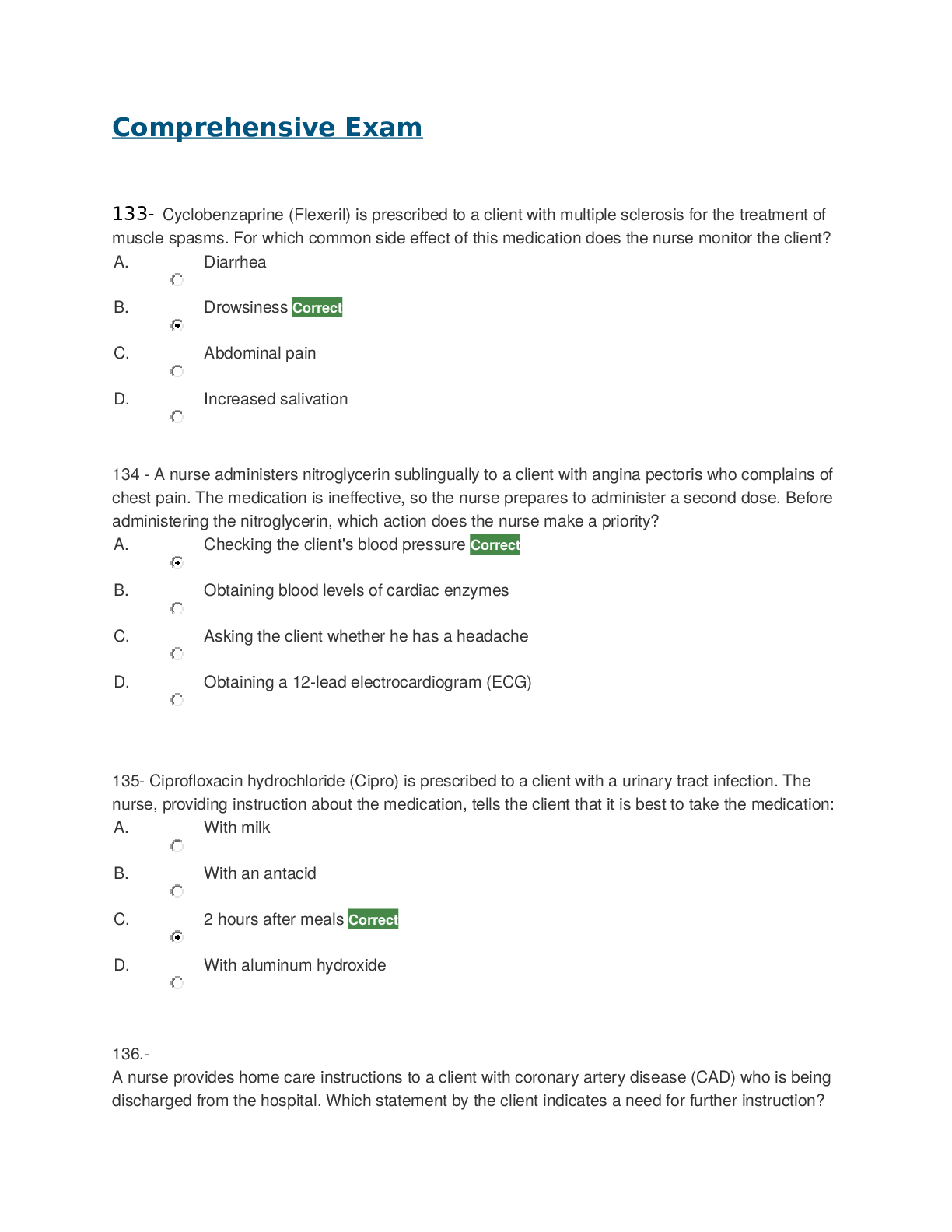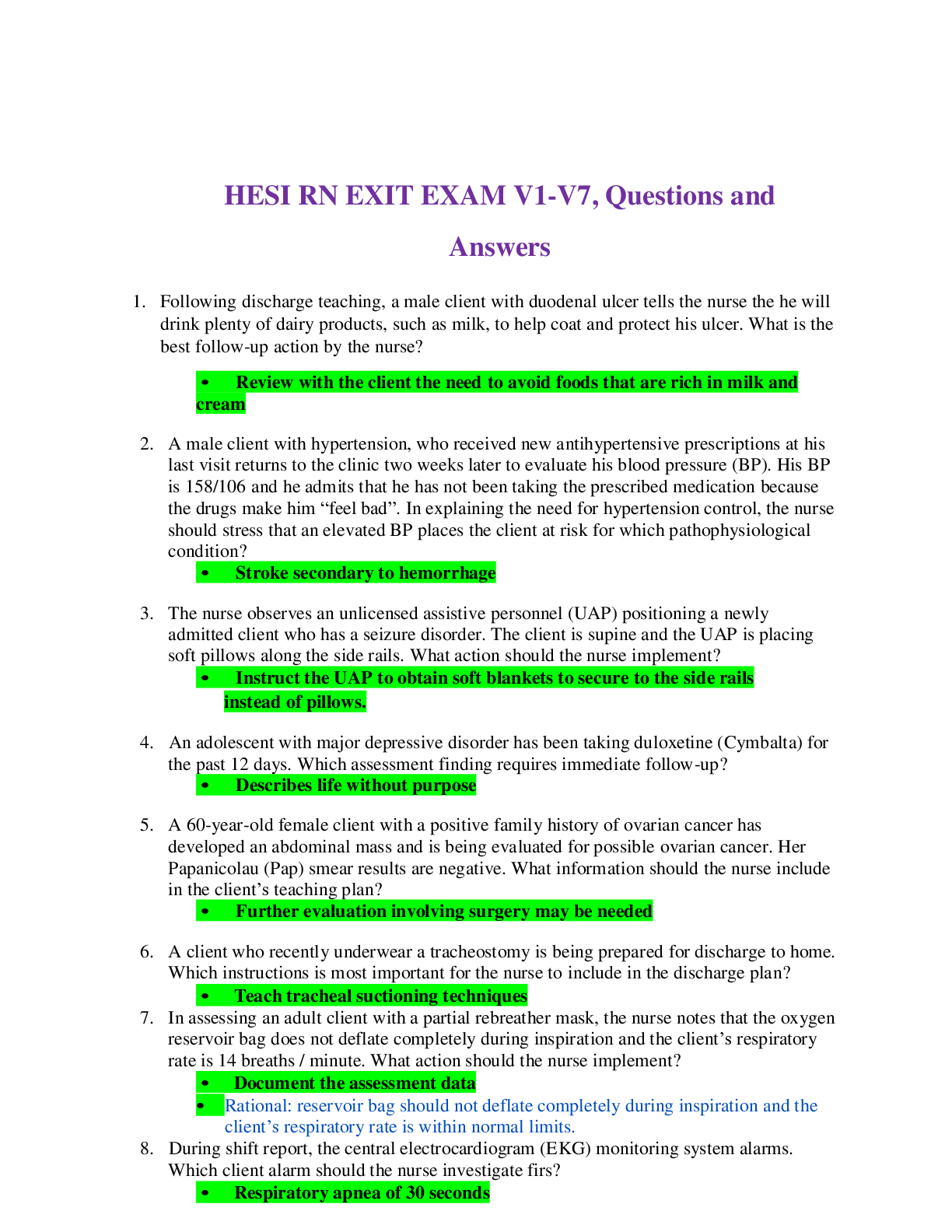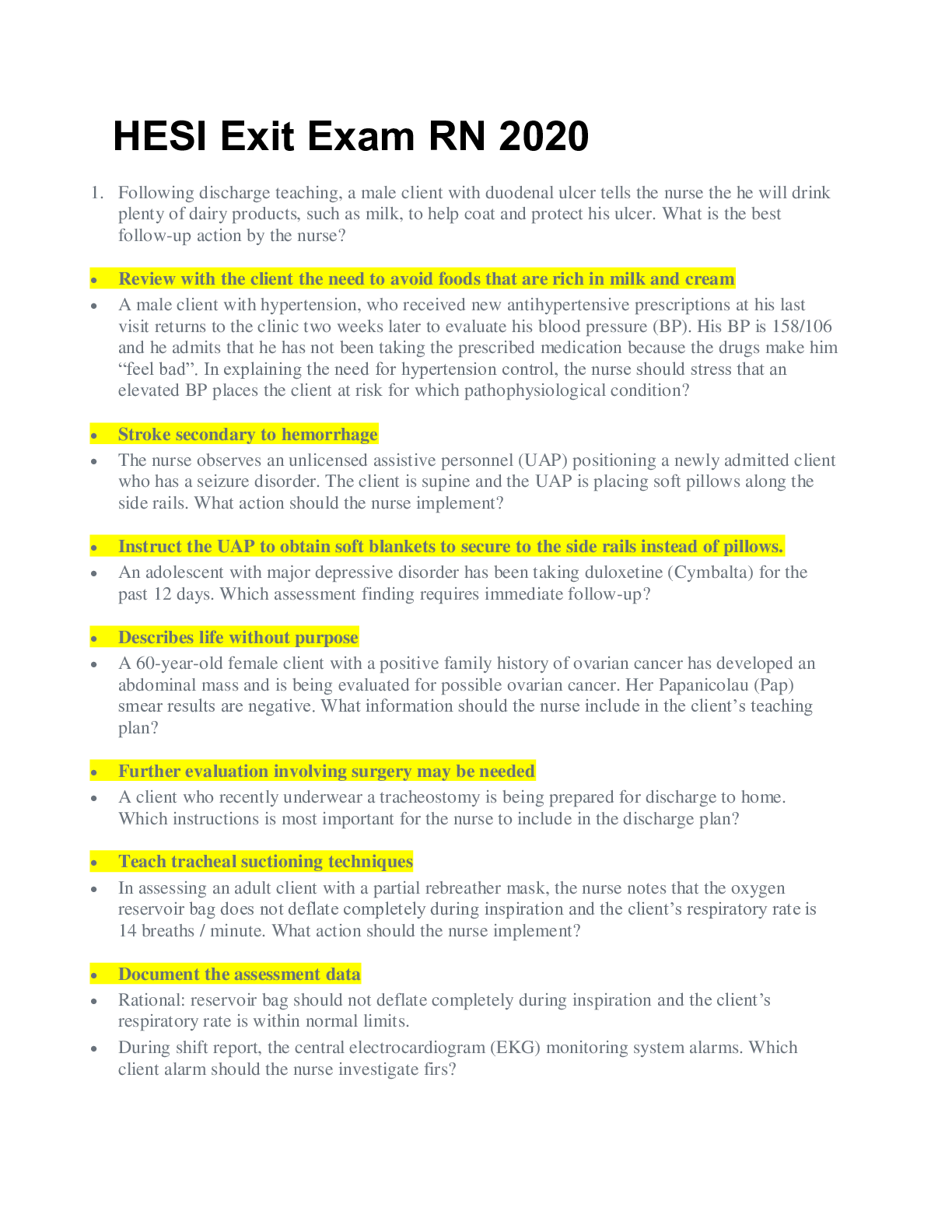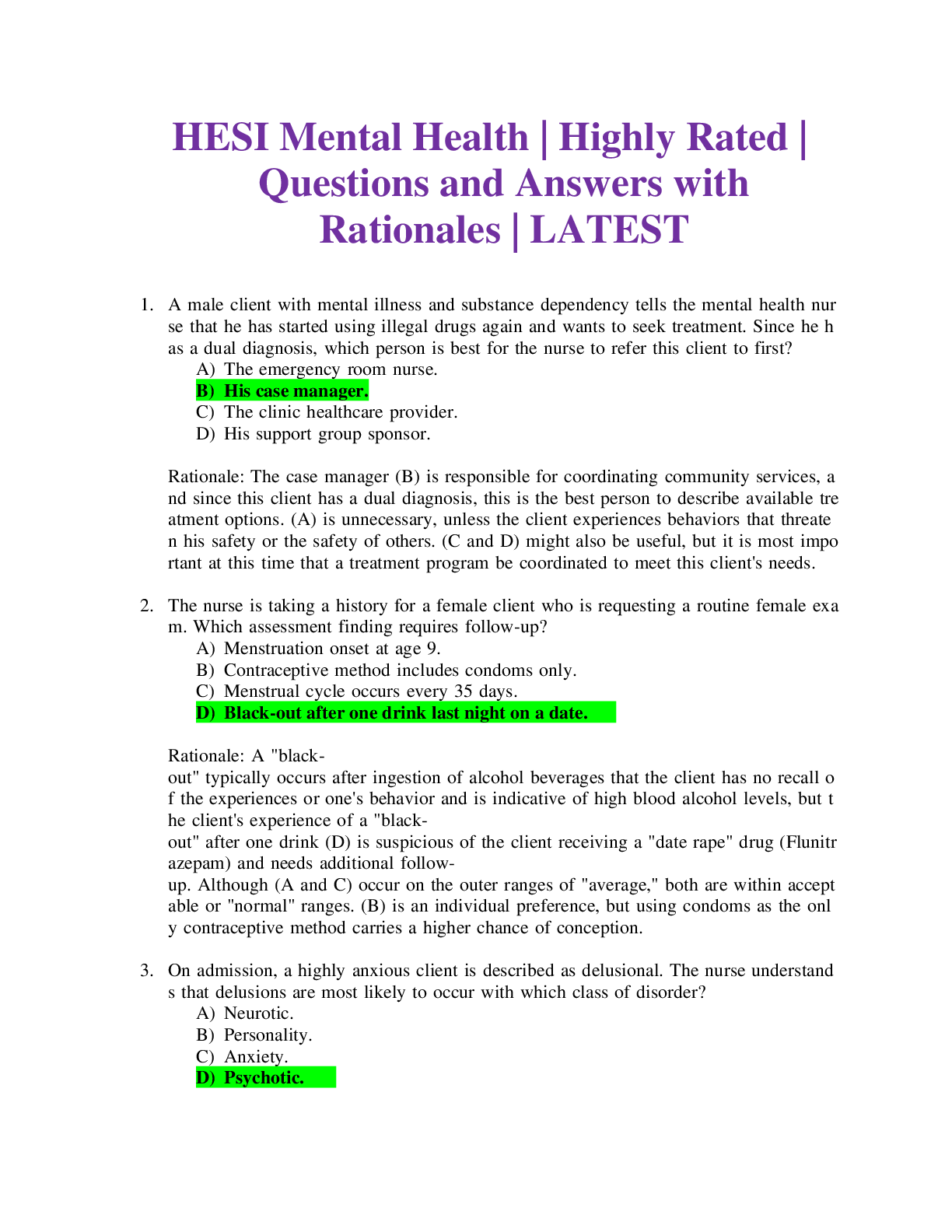*NURSING > HESI > Maternity HESI 1,2 Test Bank (Summer 2020) |Questions, Answers & Rationale, A+ Guide. (All)
Maternity HESI 1,2 Test Bank (Summer 2020) |Questions, Answers & Rationale, A+ Guide.
Document Content and Description Below
Maternity HESI 1,2 Test Bank (Summer 2020) |Questions, Answers & Rationale, A+ Guide.(well explained and understandable answers) Maternity HESI 1,2 Test Bank (2020) 1. A 38-week primigravida who work... s as a secretary and sits at a computer for 8 hours each day tells the nurse that her feet have begun to swell. Which instruction would be most effective in preventing pooling of blood in the lower extremities? 2. A 26-year-old, gravida 2, para 1 client is admitted to the hospital at 28-weeks gestation in preterm labor. She is given 3 doses of terbutaline sulfate (Brethine) 0.25 mg subcutaneously to stop her labor contractions. The nurse plans to monitor for which primary side effect of terbutaline sulfate? 3. When do the anterior and posterior fontanels close? 4. When assessing a client who is at 12-weeks gestation, the nurse recommends that she and her husband consider attending childbirth preparation classes. When is the best time for the couple to attend these classes? 5. The nurse should encourage the laboring client to begin pushing when... 6. The nurse instructs a laboring client to use accelerated-blow breathing. The client begins to complain of tingling fingers and dizziness. What action should the nurse take? 7. Twenty-four hours after admission to the newborn nursery, a full-term male infant develops localized edema on the right side of his head. The nurse knows that, in the newborn, an accumulation of blood between the periosteum and skull which does not cross the suture line is a newborn variation known as... 8. When does the head return to its normal shape? 9. What did Nurse theorist Reva Rubin describe? 10. A couple, concerned because the woman has not been able to conceive, is referred to a healthcare provider for a fertility workup and a hysterosalpingography is scheduled. Which post procedure complaint indicates that the fallopian tubes are patent? 11. Which nursing intervention is most helpful in relieving postpartum uterine contractions or "afterpains?" 12. Which maternal behavior is the nurse most likely to see when a new mother receives her infant for the first time? 13. A client at 32-weeks gestation is hospitalized with severe pregnancy-induced hypertension (PIH), and magnesium sulfate is prescribed to control the symptoms. Which assessment finding indicates the therapeutic drug level has been achieved? 14. Urinary output must be monitored when administering magnesium sulfate and should be at least 30 ml per hour. (The therapeutic level of magnesium sulfate for a PIH client is 4.8 to 9.6 mg/dl.) What is the therapeutic level of magnesium sulfate? 15. Twenty minutes after a continuous epidural anesthetic is administered, a laboring client's blood pressure drops from 120/80 to 90/60. What action should the nurse take? 16. A client at 28-weeks gestation calls the antepartum clinic and states that she is experiencing a small amount of vaginal bleeding which she describes as bright red. She further states that she is not experiencing any uterine contractions or abdominal pain. What instruction should the nurse provide? 17. An off-duty nurse finds a woman in a supermarket parking lot delivering an infant while her husband is screaming for someone to help his wife. Which intervention has the highest priority? 18. A pregnant client with mitral stenosis Class III is prescribed complete bedrest. The client asks the nurse, "Why must I stay in bed all the time?" Which response is best for the nurse to provide this client? 19. The nurse is teaching care of the newborn to a group of prospective parents and describes the need for administering antibiotic ointment into the eyes of the newborn. Which infectious organism will this treatment prevent from harming the infant? 20. The nurse is teaching a woman how to use her basal body temperature (BBT) pattern as a tool to assist her in conceiving a child. Which temperature pattern indicates the occurrence of ovulation, and therefore, the best time for intercourse to ensure conception? 21. The nurse is caring for a woman with a previously diagnosed heart disease who is in the second stage of labor. Which assessment findings are of greatest concern? 22. A woman with Type 2 diabetes mellitus becomes pregnant, and her oral hypoglycemic agents are discontinued. Which intervention is most important for the nurse to implement? 23. A client receiving epidural anesthesia begins to experience nausea and becomes pale and clammy. What intervention should the nurse implement first? 24. What is the normal bilirubin at 1 day old? 25. How do we lower the levels if they are not severe? 26. A 30-year-old gravida 2, para 1 client is admitted to the hospital at 26-weeks' gestation in preterm labor. She is given a dose of terbutaline sulfate (Brethine) 0.25 mg subcutaneous. Which assessment is the highest priority for the nurse to monitor during the administration of this drug? 27. A full-term infant is admitted to the newborn nursery and, after careful assessment, the nurse suspects that the infant may have an esophageal atresia. Which symptoms is this newborn likely to have exhibited? 28. What does a child in respiratory distress look like? 29. What does a diaphragmatic hernia look like? 30. A new mother is afraid to touch her baby's head for fear of hurting the "large soft spot." Which explanation should the nurse give to this anxious client? 31. A client who is attending antepartum classes asks the nurse why her healthcare provider has prescribed iron tablets. The nurse's response is based on what knowledge? 32. What is megaloblastic anemia caused by? 33. A woman who thinks she could be pregnant calls her neighbor, a nurse, to ask when she could use a home pregnancy test to diagnose pregnancy. Which response is best? 34. A 28-year-old client in active labor complains of cramps in her leg. What intervention should the nurse implement? 35. A client at 30-weeks’ gestation, complaining of pressure over the pubic area, is admitted for observation. She is contracting irregularly and demonstrates underlying uterine irritability. Vaginal examination reveals that her cervix is closed, thick, and high. Based on these data, which intervention should the nurse implement first? 36. A client in active labor is admitted with preeclampsia. Which assessment finding is most significant in planning this client's care? 37. What is Epogen for? 38. The healthcare provider prescribes terbutaline (Brethine) for a client in preterm labor. Before initiating this prescription, it is most important for the nurse to assess the client for which condition? 39. A client with NO prenatal care arrives at the labor unit screaming, "The baby is coming!" The nurse performs a vaginal examination that reveals the cervix is 3 centimeters dilated and 75% effaced. What additional information is most important for the nurse to obtain? 40. The nurse assesses a client admitted to the labor and delivery unit and obtains the following data: dark red vaginal bleeding, uterus slightly tense between contractions, BP 110/68, FHR 110 beats/minute, cervix 1 cm dilated and uneffaced. Based on these assessment findings, what intervention should the nurse implement? 41. Immediately after birth a newborn infant is suctioned, dried, and placed under a radiant warmer. The infant has spontaneous respirations and the nurse assesses an apical heart rate of 80 beats/minute and respirations of 20 breaths/minute. What action should the nurse perform next? 42. The nurse is preparing to give an enema to a laboring client. Which client requires the most caution when carrying out this procedure? 43. The nurse is providing discharge teaching for a client who is 24 hours postpartum. The nurse explains to the client that her vaginal discharge will change from red to pink and then to white. The client asks, "What if I start having red bleeding AFTER it changes?" What should the nurse instruct the client to do? 44. One hour after giving birth to an 8-pound infant, a client's lochia rubra has increased from small to large and her fundus is boggy despite massage. The client's pulse is 84 beats/minute and blood pressure is 156/96. The healthcare provider prescribes Methergine 0.2 mg IM × 1. What action should the nurse take immediately? 45. A client at 32-weeks’ gestation is diagnosed with preeclampsia. Which assessment finding is most indicative of an impending convulsion? 46. A client at 32-weeks’ gestation comes to the prenatal clinic with complaints of pedal edema, dyspnea, fatigue, and a moist cough. Which question is most important for the nurse to ask this client? 47. After each feeding, a 3-day-old newborn is spitting up large amounts of Enfamil® Newborn Formula, a nonfat cow's milk formula. The pediatric healthcare provider changes the neonate's formula to Similac® Soy Isomil® Formula, a soy protein isolate based infant formula. What information should the nurse provide to the mother about the newly prescribed formula? 48. The nurse is performing a gestational age assessment on a full-term newborn during the first hour of transition using the Ballard (Dubowitz) scale. Based on this assessment, the nurse determines that the neonate has a maturity rating of 40-weeks. What findings should the nurse identify to determine if the neonate is small for gestational age (SGA)? (Select all that apply.) 49. The nurse is assessing a client who is having a non-stress test (NST) at 41-weeks gestation. The nurse determines that the client is not having contractions, the fetal heart rate (FHR) baseline is 144 bpm, and no FHR accelerations are occurring. What action should the nurse take? 50. A vaginally delivered infant of an HIV positive mother is admitted to the newborn nursery. What intervention should the nurse perform first? 51. A client who is in the second trimester of pregnancy tells the nurse that she wants to use herbal therapy. Which response is best for the nurse to provide? 52. A primigravida client who is 5 cm dilated, 90% effaced, and at 0 station is requesting an epidural for pain relief. Which assessment finding is most important for the nurse to report to the healthcare provider? 53. A 24-hour-old newborn has a pink papular rash with vesicles superimposed on the thorax, back, and abdomen. What action should the nurse implement? 54. When explaining "postpartum blues" to a client who is 1 day postpartum, which symptoms should the nurse include in the teaching plan? (Select all that apply.) 55. The nurse should explain to a 30-year-old gravid client that alpha fetoprotein testing is recommended for which purpose? 56. The nurse identifies crepitus when examining the chest of a newborn who was delivered vaginally. Which further assessment should the nurse perform? 57. A primigravida at 40-weeks gestation is receiving oxytocin (Pitocin) to augment labor. Which adverse effect should the nurse monitor for during the infusion of Pitocin? 58. A multigravida client at 41-weeks gestation presents in the labor and delivery unit after a non-stress test indicated that the fetus is experiencing some difficulties in utero. Which diagnostic test should the nurse prepare the client for additional information about fetal status? 59. While breastfeeding, a new mother strokes the top of her baby's head and asks the nurse about the baby's swollen scalp. The nurse responds that the swelling is caput succedaneum. Which additional information should the nurse provide this new mother? 60. A healthcare provider informs the charge nurse of a labor and delivery unit that a client is coming to the unit with suspected abruptio placentae. What findings should the charge nurse expect the client to demonstrate? (Select all that apply.) 61. A client with gestational hypertension is in active labor and receiving an infusion of magnesium sulfate. Which drug should the nurse have available for signs of potential toxicity? 62. A 42-week gestational client is receiving an intravenous infusion of oxytocin (Pitocin) to augment early labor. The nurse should discontinue the oxytocin infusion for which pattern of contractions? 63. The nurse is preparing a client with a term pregnancy who is in active labor for an amniotomy. What equipment should the nurse have available at the client's bedside? 64. A client at 32-weeks gestation is diagnosed with preeclampsia. Which assessment finding is most indicative of an impending convulsion? 65. During labor, the nurse determines that a full-term client is demonstrating late decelerations. In which sequence should the nurse implement these nursing actions? (Arrange in order.) 66. What is the Silverman-Anderson Index? 67. Define Milia 68. Define Pseudo strabismus 69. Define Subarachnoid hematoma 70. Hysterosalpingography (HSG) AKA uterosalpingography 71. Define amniotomy 72. Define hyper clonus 73. Total placental previa 74. What is Methergine for? 75. How many wet diapers per day? 76. Define Terbutaline sulfate (Brethine) 77. Procardia (Nifedipine) what is it used for? 78. non-stress test (NST) - how to pass? 79. What is Alpha-fetoprotein (AFP)? 80. Define Biophysical profile (BPP) It scores the fetuses responses to stimuli, is non-invasive, and based on acute and chronic markers of fetal disease. 81. Define Preeclampsia: Maternity HESI 2 1. Which nursing intervention is most helpful in relieving postpartum uterine contractions or "afterpains?" a. Lying prone with a pillow on the abdomen b. Using a breast pump c. Massaging the abdomen d. Giving oxytocic medications 2. A multigravida client arrives at the labor and delivery unit and tells the nurse that her bag of water has broken. The nurse identifies the presence of meconium fluid on the perineum and determines the fetal heart rate is between 140 to 150 beats/minute. What action should the nurse implement next? a. Complete a sterile vaginal exam b. Take maternal temperature every 2 hours c. Prepare for an immediate cesarean birth d. Obtain sterile suction equipment 3. When explaining "postpartum blues" to a client who is 1 day postpartum, which symptoms should the nurse include in the teaching plan? (Select all that apply.) a. Mood swings b. Panic attacks c. Tearfulness d. Decreased need for sleep e. Disinterest in the infant 4. A client at 30-weeks gestation, complaining of pressure over the pubic area, is admitted for observation. She is contracting irregularly and demonstrates underlying uterine irritability. Vaginal examination reveals that her cervix is closed, thick, and high. Based on these data, which intervention should the nurse implement first? a. Provide oral hydration b. Have a complete blood count (CBC) drawn c. Obtain a specimen for urine analysis d. Place the client on strict bedrest 5. A client in active labor complains of cramps in her leg. What intervention should the nurse implement? a. Ask the client if she takes a daily calcium tablet b. Extend the leg and dorsiflex the foot c. Lower the leg off the side of the bed d. Elevate the leg above the heart b. Extend the leg and dorsiflex the foot 6. The nurse is caring for a woman with a previously diagnosed heart disease who is in the second stage of labor. Which assessment findings are of greatest concern? a. edema, basilar rales, and an irregular pulse b. Increased urinary output, and tachycardia c. Shortness of breath, bradycardia, and hypertension d. Regular heart rate, and hypertension 7. The nurse is teaching a woman how to use her basal body temperature (BBT) pattern as a tool to assist her in conceiving a child. Which temperature pattern indicates the occurrence of ovulation, and there for, the best time for intercourse to ensure conception? a. Between the time the temperature falls and rises b. Between 36 and 48 hours after the temperature rises c. When the temperature falls and remains low for 36 hours d. Within 72 hours before the temperature falls 8. A client who is in the second trimester of pregnancy tells the nurse that she wants to use herbal therapy. Which response is best for the nurse to provide? a. Herbs are a corner stone of good health to include in your treatment b. Touch is also therapeutic in relieving discomfort and anxiety c. Your healthcare provider should direct treatment options for herbal therapy d. It is important that you want to take part in your care 9. A mother who is breastfeeding her baby receives instructions from the nurse. Which instruction is most effective to prevent nipple soreness? a. Wear a cotton bra b. Increase nursing time gradually c. Correctly place the infant on the breast d. Manually express a small amount of milk before nursing 10. The nurse is counseling a woman who wants to become pregnant. The woman tells the nurse that she has a 36-day menstrual cycle and the first day of her menstrual period was January *. The nurse correctly calculates that the woman's next fertile period is a. January 14-15 b. January 22-23 c. January 30-31 d. February 6-7 11. The nurse should encourage the laboring client to begin pushing when a. there is only an anterior or posterior lip of cervix left b. the client describes the need to have a bowel movement c. the cervix is completely dilated d. the cervix is completely effaced 12. One hour after giving birth to an 8-pound infant, a client's lochia rubra has increased from small to large and her fundus is boggy despite massage. The client's pulse is 84 beats/minute and blood pressure is 156/96. The healthcare provider prescribes Methergine 0.2 mg IM x 1. What action should the nurse take immediately? a. Give the medication as prescribed and monitor for efficacy b. Encourage the client to breastfeed rather than bottle feed c. Have the client empty her bladder and massage the fundus d. Call the healthcare provider to question the prescription 13. A newborn, whose mother is HIV positive, is scheduled for follow-up assessments. The nurse knows that the most likely presenting symptom for a pediatric client with AIDS is: a. shortness of breath b. joint pain c. a persistent cold d. organomegaly 14. A healthcare provider informs the charge nurse of a labor and delivery unit that a client is coming to the unit with suspected abruptio placentae. What findings should the charge nurse expect the client to demonstrate? [Show More]
Last updated: 1 year ago
Preview 1 out of 17 pages

Reviews( 0 )
Document information
Connected school, study & course
About the document
Uploaded On
Jan 21, 2021
Number of pages
17
Written in
Additional information
This document has been written for:
Uploaded
Jan 21, 2021
Downloads
0
Views
37

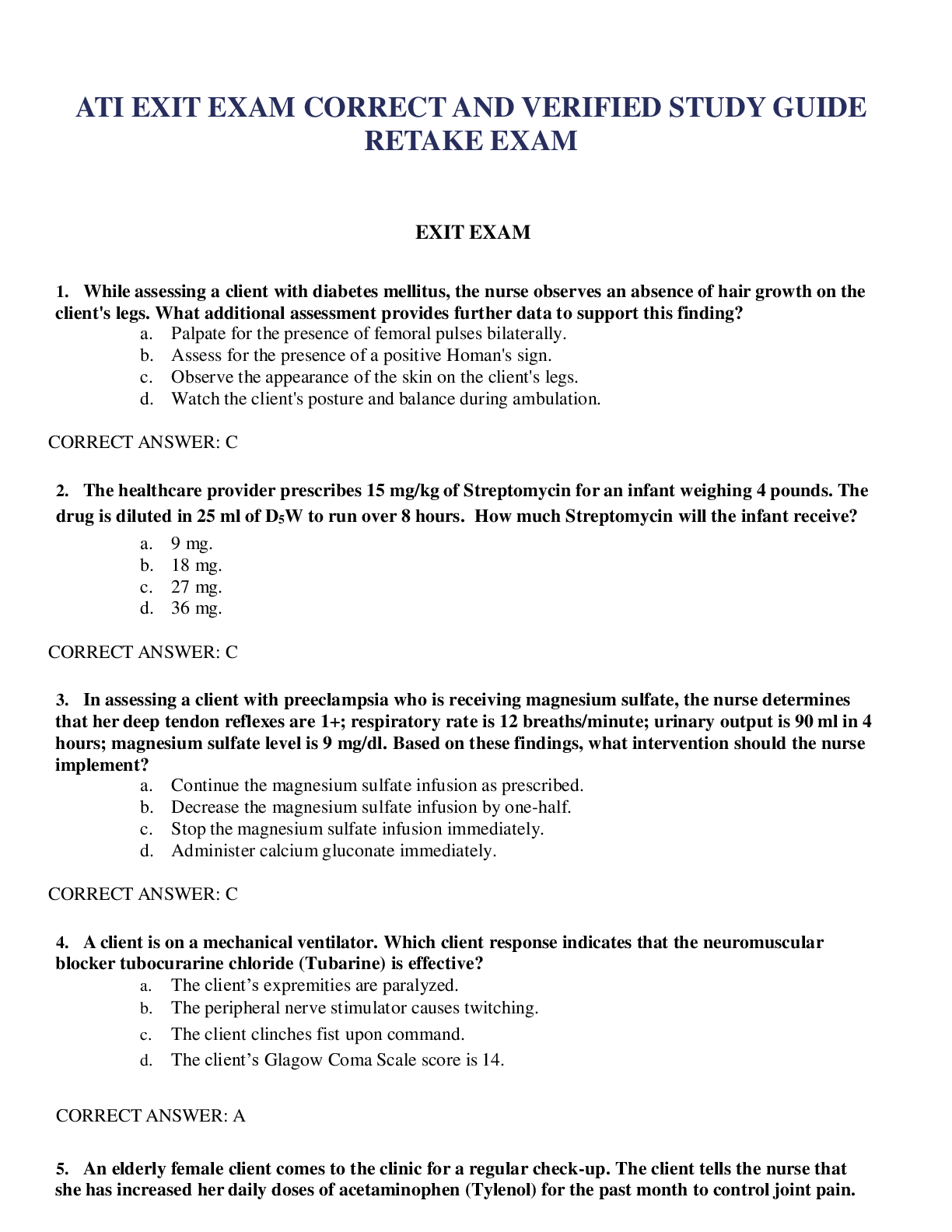

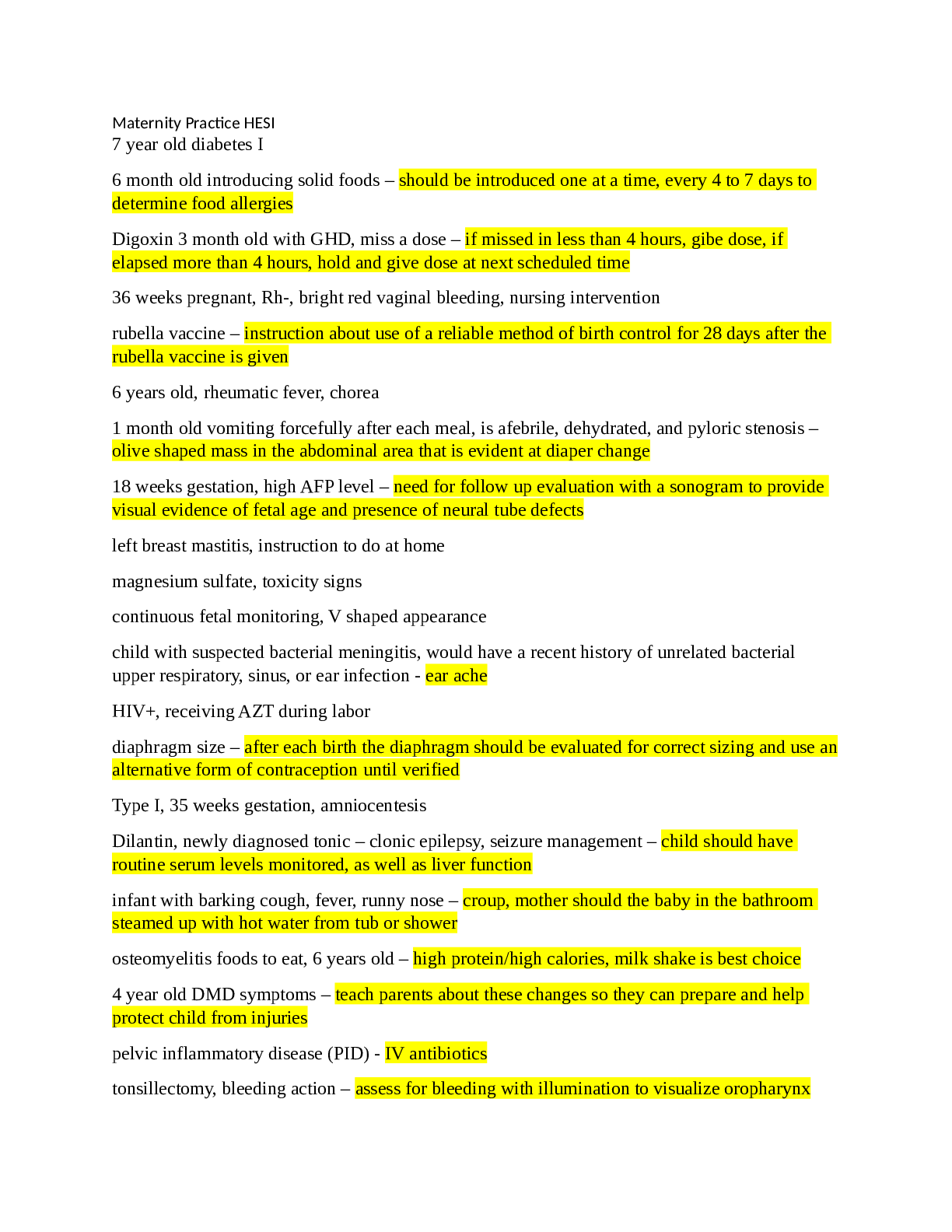




.png)

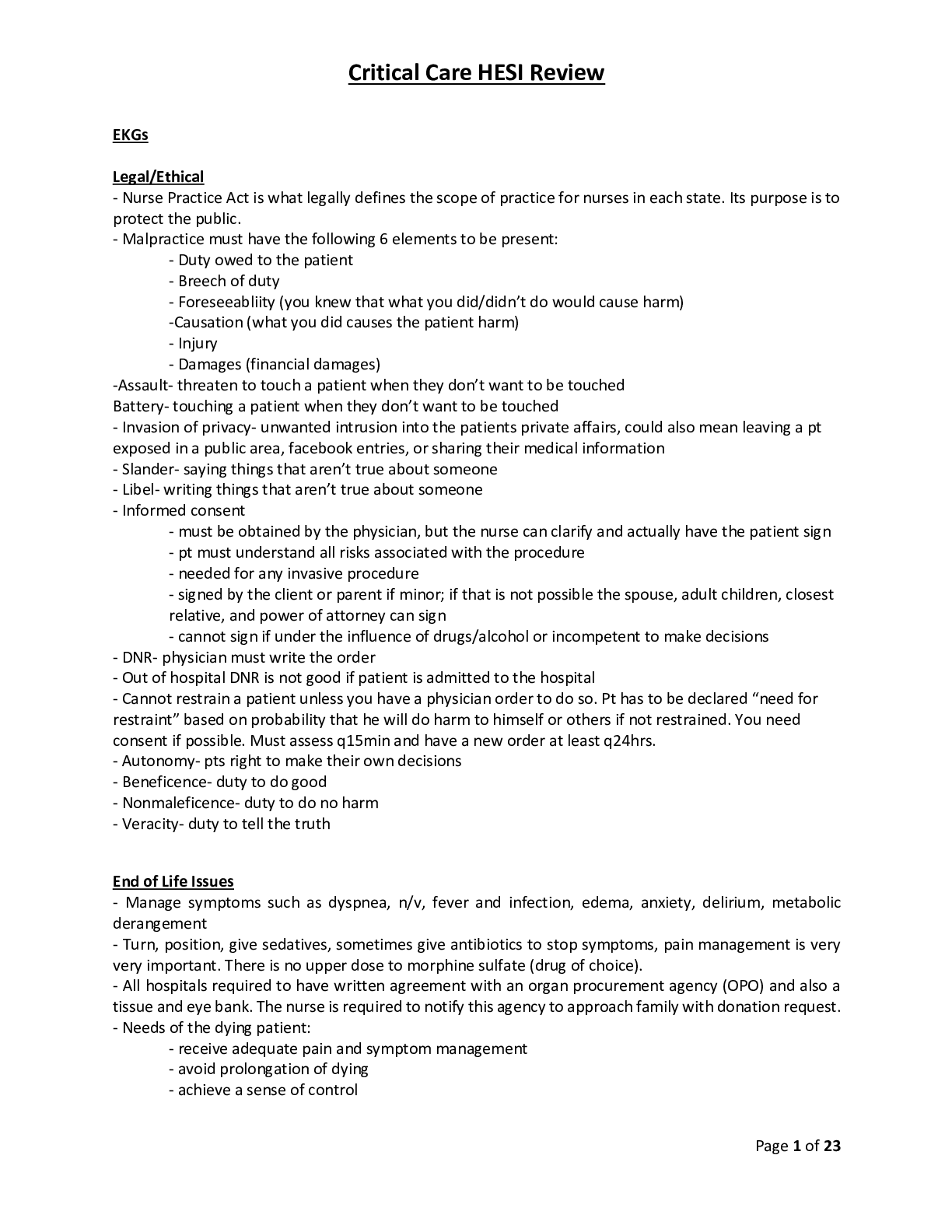
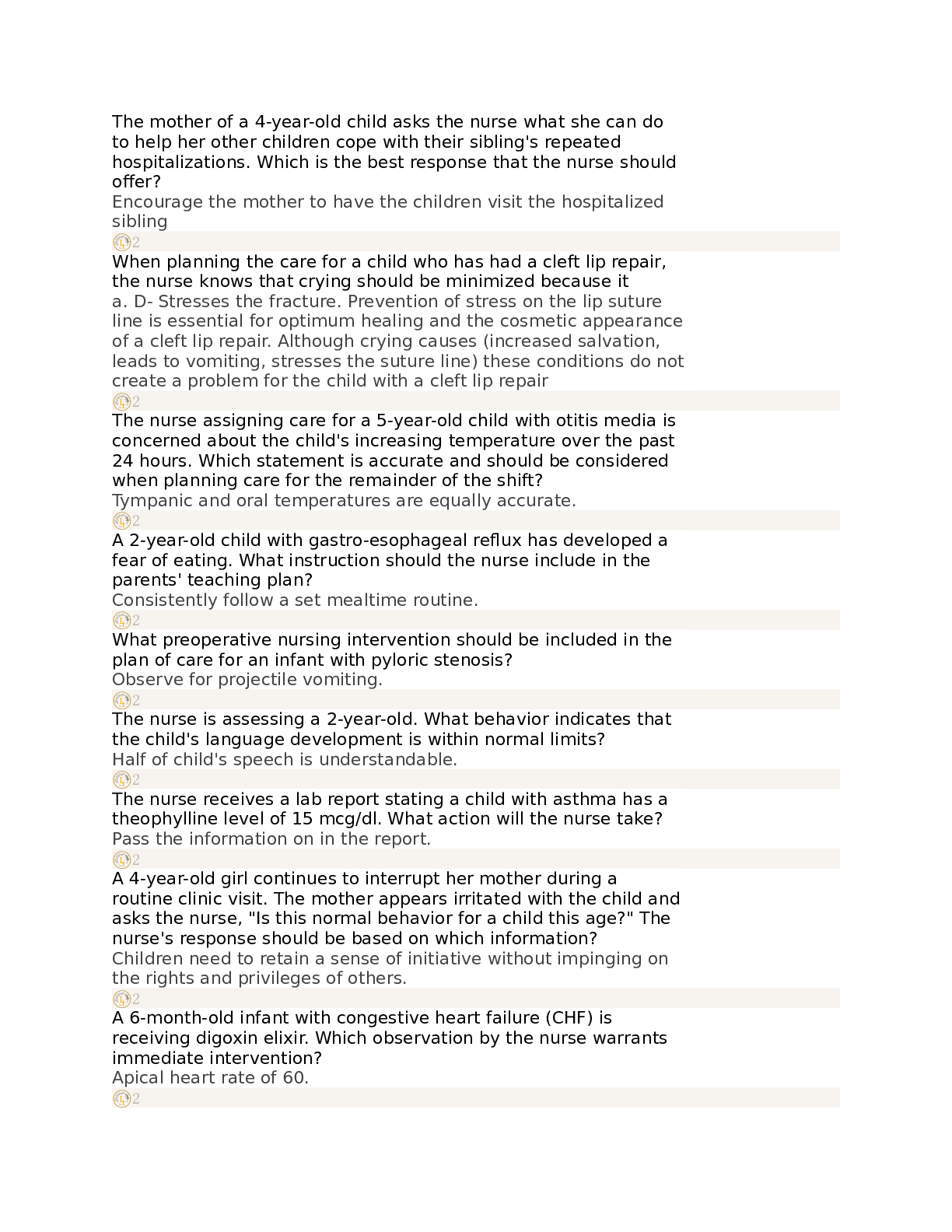
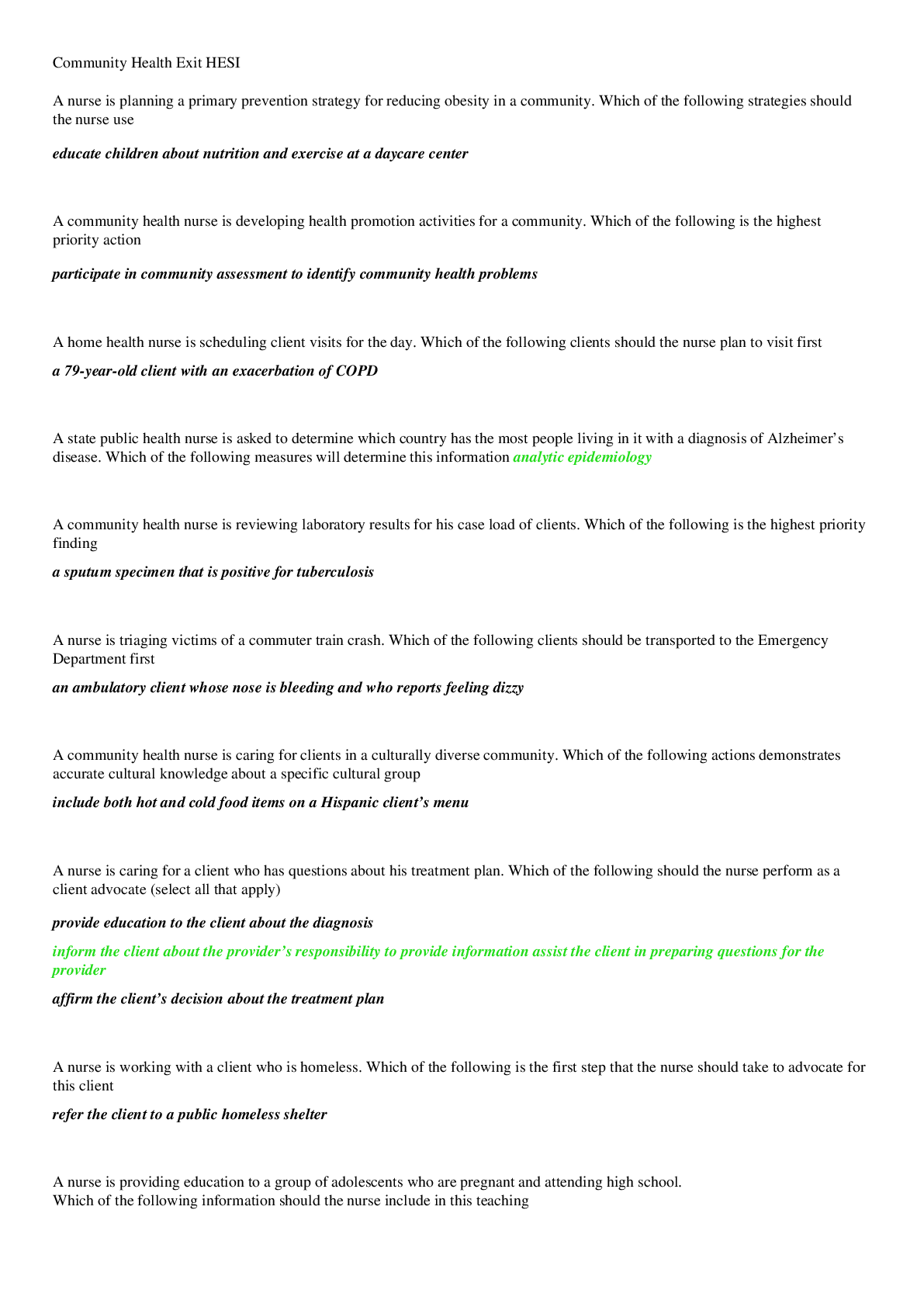
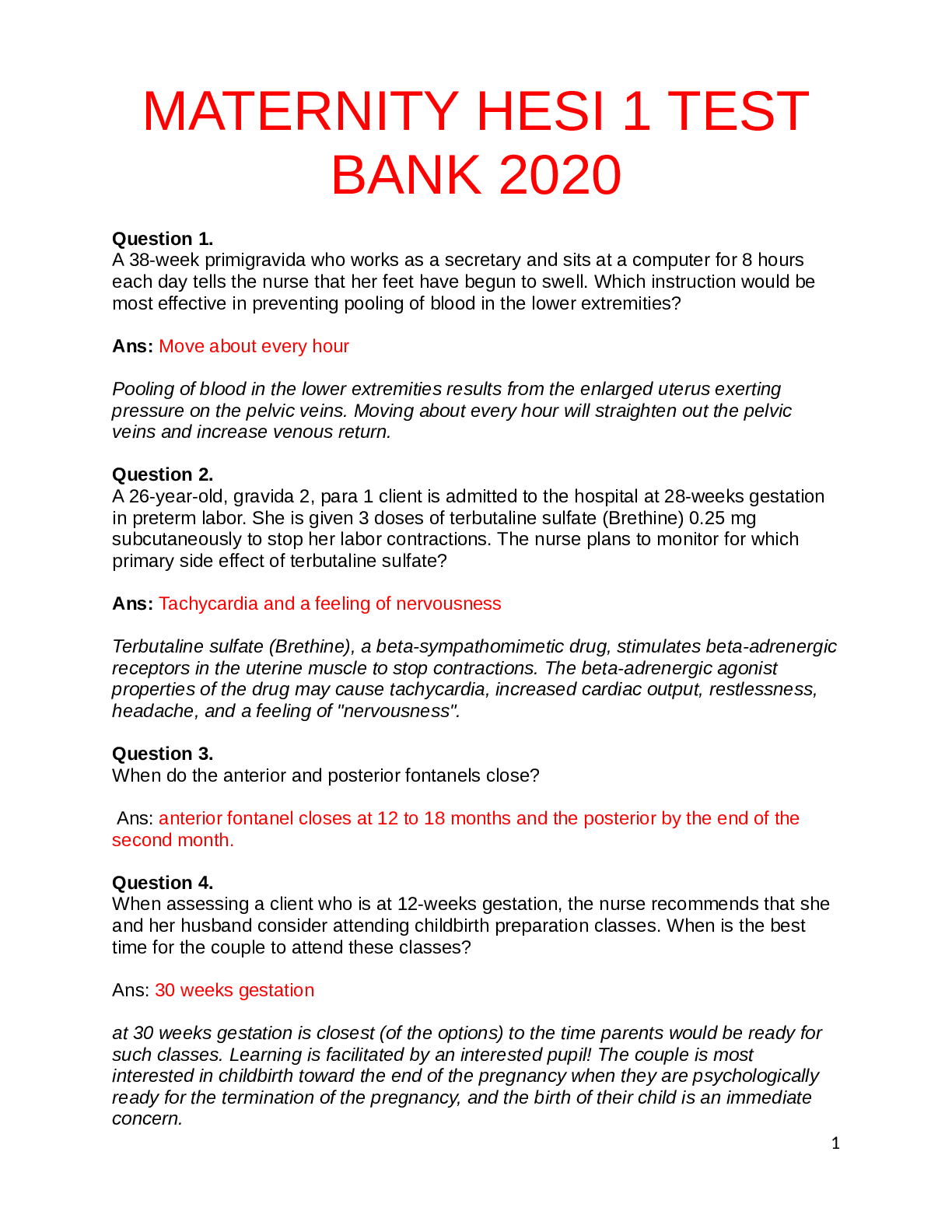

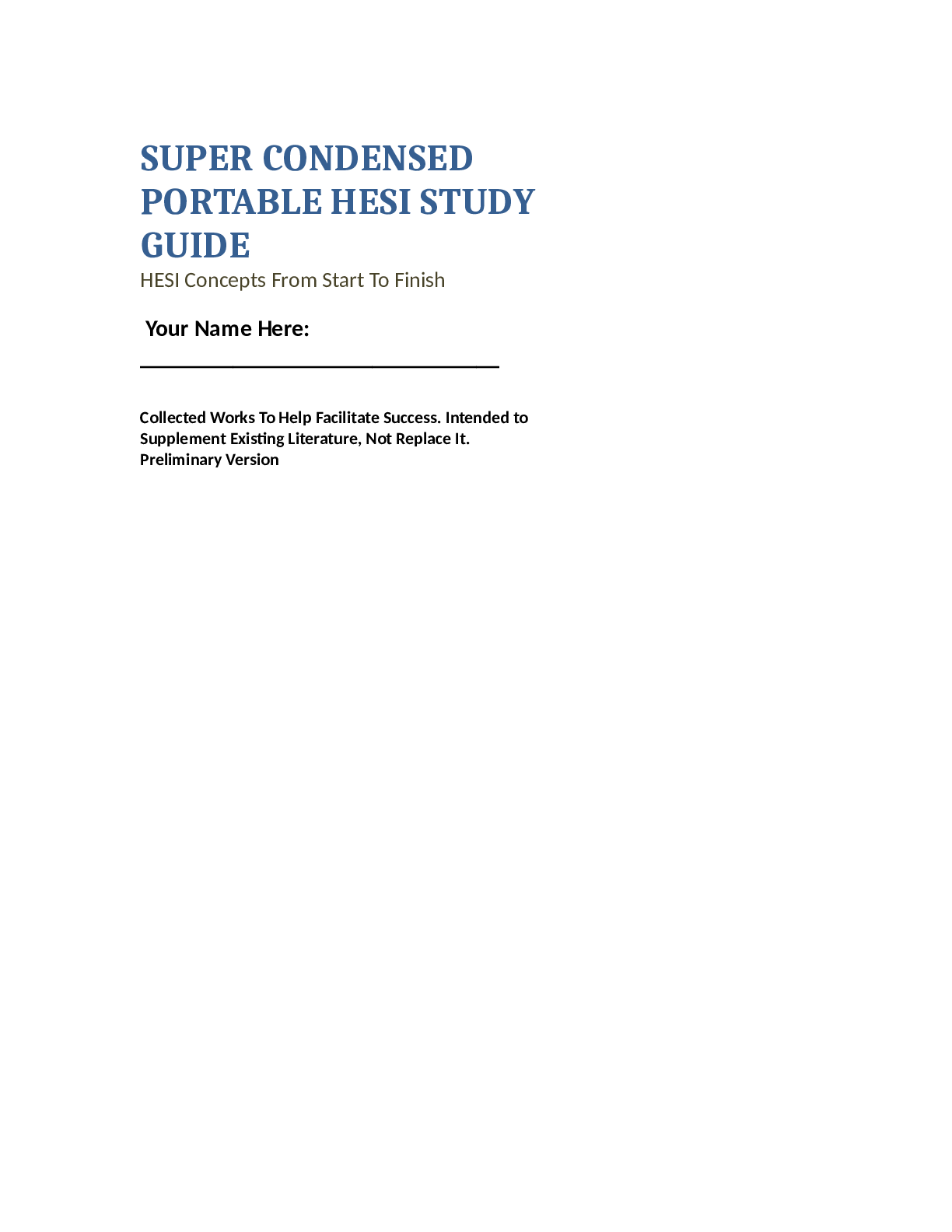




 (1).png)



